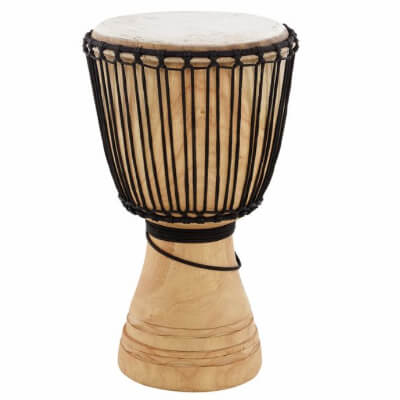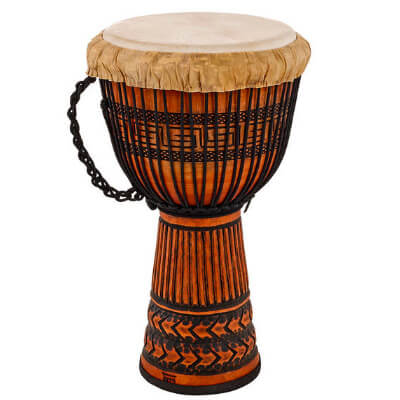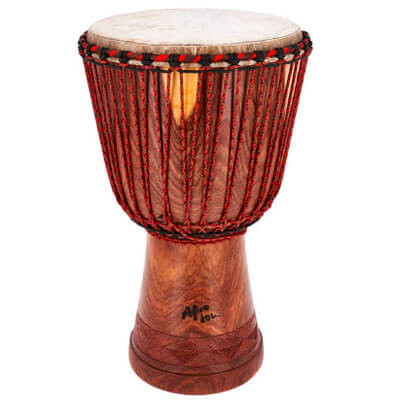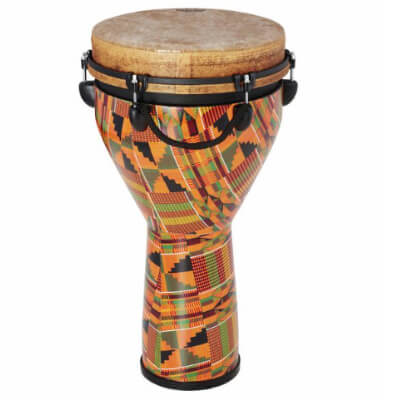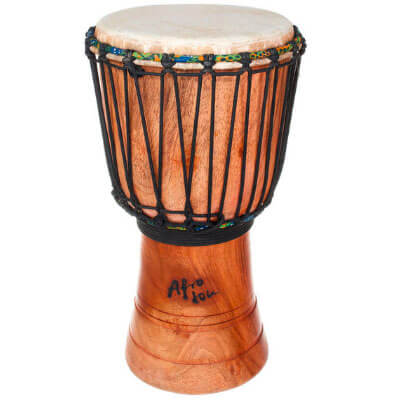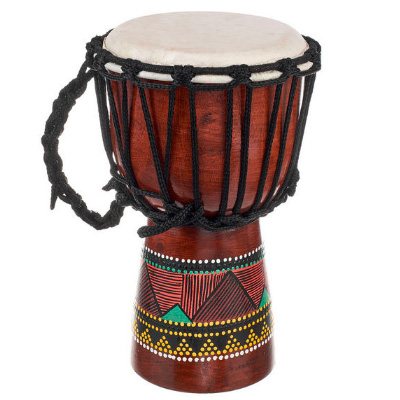Buying Djembé: My 7 best recommendations 2025
These are my current recommendations for djembe drums specifically for beginners, advanced players or kids. It’s best to read through the answers to the “frequently asked questions” so that you have all the important information before buying a djembe.
This text has been translated into English. Please report spelling mistakes to sebastian@musiksocke.com
What kind of djembe are you looking for?
Frequently asked questions:
Djembe for beginners
It is especially difficult for beginners to find the right drum. Beginners should play a good quality djembe from the start. The better the drum sounds, the more fun it is to play and the greater the stamina.
The Thomann NN32 Djembé V2 has a great sound and is best suited for beginners. It is handmade in the African state of Ivory Coast from local hardwood. The drum is covered with natural skin and has a tunable string tension. Bass and tone are very differentiated and offer a pleasant sound. The skin diameter is 32 cm and the djembe is about 60 cm high. In the range of less than 200 euros, this drum offers the best price-performance ratio and is therefore well suited for beginners.
The Terre 504 Africa Djembe is a good drum with an authentic design. I would also classify the sound as typically African. It has a powerful bass and clear slaps. However, the sound varies greatly depending on which djembe you try. This is due to the handwork and the different pieces of wood. Therefore, no two djembe are alike. This is also noticeable in the fact that the diameter can vary between 30 and 33 cm.
Djembe for advanced players
Advanced djembe drums are exclusively handmade. The sound is significantly influenced by the woods used and their correct processing. To enjoy your djembe for a long time, it is worth spending a little more money.
The high-quality Afroton AD-M03 Masterclass Djembé is handmade from African hardwood, covered with selected goatskin and discreetly decorated. The sound is first class and offers powerful basses, clear tones and brilliant slaps. The Afroton AD-M03 Masterclass Djembe is ideally suited as a solo instrument and for drum teachers. The height is 64 to 65 cm and the diameter 33 to 35 cm.
The Remo Djembe DJ-0012-PM is a high-quality drum for ambitious musicians. It is not a classic djembe, but has a synthetic head and can be tuned with a tuning key. It can also be used by soloists, as the drum has a balanced sound with wonderful depths. In terms of sound, the djembe is in no way inferior to the classical construction. An exciting drum that is much less sensitive due to its “modern” construction and is very easy to tune.
Djembe for kids
There are no special djembes for kids, as there is a wide range of small drums that can be played by kids as well as adults. The instrument can therefore still be used when the kid has grown up. Therefore, it is advisable to buy a high-quality instrument directly and to refrain from buying cheap plastic djembes.
The Afroton AD 007 djembe has a beautiful and differentiated sound. Its small size between 38 and 42 cm and a diameter between 22 and 24 cm are wonderfully suitable for children’s hands. The drum is beautifully decorated and handmade in Ghana. Each djembe is unique and may therefore differ slightly from the product picture. For kids, this drum currently offers the best value for money.
The Thomann BN16 Djembe is a mini version of a standard Djembe and offers a beautiful sound for the small sound box. With a height of only 30 cm and a head diameter of 16 cm, it is ideal for kids and can be clamped comfortably between the legs. It is a fully-fledged instrument consisting of mahogany and a covering of goatskin. Only the bass has to be cut back due to the size.
Djembe for crazy people
A completely crazy djembe is the LP 799X-AW Galaxy Djembe. Designed as a high-end drum, this djembe does not come from Africa, but from the USA. North American ash wood was used. This is noticeable in the very bass-heavy sound. The height is 65 cm and as a further highlight the hardware is gold-plated. Who doesn’t dream of this perfect instrument?
How do I recognize a good djembe?
You should consider the following criteria if you are thinking of buying a djembe.
Quality – It takes a drum maker at least two weeks to make a high-quality djembe. In addition, there is a drying period of nine months. The djembe is traditionally an African musical instrument. Therefore, the drums from Africa show a high attention to detail and correspondingly good workmanship. Industrially manufactured djembe drums from Asia and drums with plastic bodies are not recommended. A good djembe should be carved from African precious wood, for example bush mango, Lenké, mahogany, iroko or rosewood. Lenké and rosewood are considered the best tonewoods, followed by bush mango and mahogany. Inferior drums are often made of melina, palm or tweneboa wood. When bracing, the distance between the knots should be about two finger widths.
Size & weight – To be able to play the djembe well while sitting, it should be 55 to 65 centimetres high for adults, depending on the size. For kids, a height of 30 to 55 centimetres is recommended. It is important that the thighs are not in the way when drumming. A djembe for adults should have a diameter of at least 30 to 32 centimetres so that it can be played with both hands without the hands touching each other. The weight of a djembe is especially important so that it can be played standing up with a carrying strap. For adults, the drum should have a weight of at least 6 kilograms. A djembe for men should weigh less than 9 kilograms, for women up to 8 kilograms. Strong drummers can also manage well with a heavier djembe weighing up to 12 kilograms.
Sound – A djembe should sound warm and offer a wide variety of sounds. This includes a deep bass, a bright slap and an incisive tone. The best way to find out which sound suits you is to try it out and go with your gut feeling. An instrument made of high-quality African hardwood has a better sound volume than a djembe made of softwood.
Optics – Of course, your djembe should also look good. This increases the joy of playing and the passion for drumming. A beautiful djembe is decorative and a real eye-catcher in the home. The look of an instrument is determined by many aspects, such as the shape of the drum, the colour and grain of the wood, the drumhead, painting or carved details.
What accessories do I need?
You will need some accessories to protect and transport your djembe. In addition, the valuable instrument should be cared for with a suitable product from time to time. If you protect your djembe sufficiently and care for it regularly, you will have many years of fun with your instrument.
To protect the skin of the djembe, a suitable cover made of sturdy, water-repellent and washable material is recommended. The protective cover should have soft padding. The size of the cover must fit the diameter of the drum. The Toca Djembe Head Cover has a practical elastic band and fits all 14″ djembes (35.56 cm).
Special bags for djembe are available in several sizes and made of different materials. The djembe must fit comfortably into the bag. The material should be tear-resistant, stable, water-repellent and washable, such as nylon. The bag should have good padding. For comfortable transport, it should be equipped with both a carrying strap or a backpack strap. My recommendation for this is the Millenium 12″-14″ djembe bag. It is sturdy and well lined on the inside.
If you want to play the djembe standing up, you need a suitable strap. The straps are available in different lengths. A good model is the Terre Djembe Back Pack Pro Black. Especially tall or short people will have problems with the strap, but for most musicians the fit is suitable and the djembe can be carried comfortably while standing.
With the right care products, a djembe can last for many years. Oiling or greasing the drumhead is not necessary. The skin is cared for by regular playing with the hands. Stains on the drumhead can be removed with a sponge, washing-up liquid and water. There are various wood care products for the body of the djembe.
Care products for a djembe:
- Wood butter – Wood butter is a 100 percent natural care product. It cares for and protects the drum from drying out and prevents the formation of cracks.
- Karité Butter – African Karité Butter is a wood care product on a 100 percent natural basis without chemical additives. It protects the wood from moisture, weathering and sunlight. At the same time, it prevents cracking and drying out.
- Pistal – The natural insecticide Pistal is recommended for pest control. The active ingredient is extracted from African chrysanthemums and destroys wood-destroying insects.
- Bambule – Bambule is non-toxic and drives insects out of drumheads and unpleasant odours are neutralised. The active ingredient neem extract is made from the African tree Azadirachta and lavender oil.
What are the best brands for a djembe?
Experienced musicians have compiled a list of the best brands in cooperation with me. It was important to us that the brands have maintained a consistently high quality of their instruments over the past decades.
How much does a good djembe cost?
A good djembe costs between 200 and 500 euros. For beginners, there are already good entry-level models in the range between 100 and 200 euros. The difference lies above all in the woods used. The quality of the African precious woods has a direct effect on the sound. Frequent drummers notice the difference and should invest in a good djembe.
Here is my recommendation for a good djembe.
What is the best djembe for beginner?
As a djembe for beginners, the Thomann NN32 Djembé V2 is suitable for approx. 160 euros. It is easy to play and produces a beautiful bass. In my opinion, the djembe has the best price-performance ratio among the beginner models.
The Afroton AD-M03 Masterclass Djembe for about 430 Euros is suitable as an advanced djembe. It is easy to tune and can therefore be perfectly adjusted to one’s own playing style. The powerful bass and clear slaps are particularly suitable for soloists.
More details about the Djembe for beginners.
⚠️
* For the links marked with a star, we receive a commission on a purchase. The price does not change for you. Please use our link and support the independent work of Musiksocke. Thank you very much!
✔️
The product recommendations made here are based on my experience and conversations with expert musicians. All products presented here meet the criteria of the checklist.
🏦
All prices are incl. VAT plus shipping costs. The amount was estimated by me and may differ from the actual price. As an Amazon partner, I earn on qualified sales. This also applies to Thomann, Kirstein and all other partners.
String instruments:
Wind instruments:
Key instruments:
Drums:
Recording:


